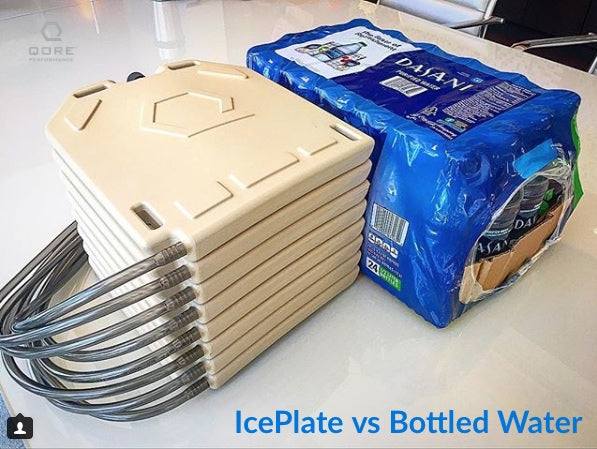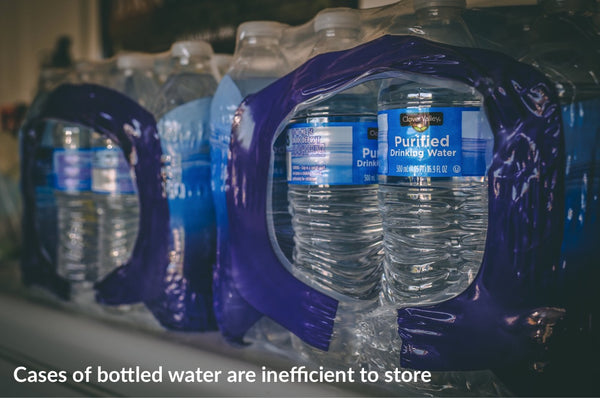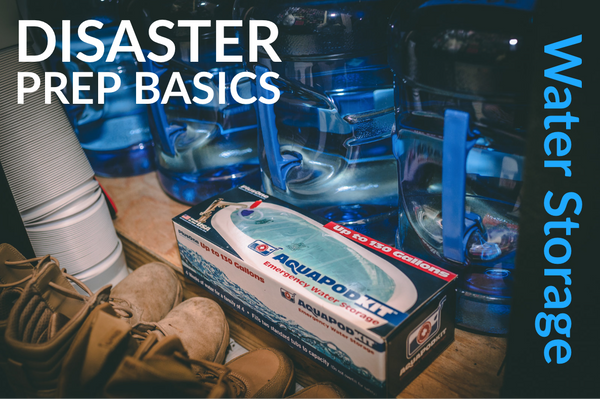Best Emergency Water Storage Options for Natural Disasters, Medical Quarantine, Wild Fires, Earthquakes
Over the last few years, we have experienced devastating natural disasters here in the United States in hurricanes Maria and Harvey. Wildfires, once a seasonal phenomenon, have now become a common, year-round occurrence on the West coast (you can read more about our experience with wild fire response here). Now, we are faced with a global pandemic in the novel Coronavirus. These frequent disasters have made household disaster preparation and water storage more specifically, an increasingly important issue. There are many fantastic resources showing why storing water is important. Instead we are going to discuss how to store water in today's homes. In particular, we are going to focus on water storage density. In order to properly store water for a disaster we must consider three main factors:
-How much do I need?
-Where do I store it?
-How do I store it?
How much do I need? Per the Centers for Disease Control, each person in your home requires one gallon of water per day under normal circumstances. This amount increases due to special circumstances such as metabolic activity (physical exertion), extreme temperatures, illness, or pregnancy. At a bare minimum you should have 72 hours of clean water. In an ideal scenario, you should have two weeks of water. If you have a two person household then you would need six gallons of water for the CDC minimum 72 hour supply. You would need 28 gallons of water to meet the CDC guidelines for an ideal scenario. If you have a four person family this would double to 12 gallons and 56 gallons respectively.

Where do I store it? Populations in the world’s leading cities have been migrating into cities for the past decade. Cities have jobs and that means people will naturally desire homes in the city to avoid longer commutes. Land prices have drastically increased because of this urbanization trend. This means a greater percentage of the population in a given metropolitan are living in smaller spaces. Smaller living spaces means less square footage per person and less space to store basic disaster preparations. Coupled with the increase in the frequency and intensity of natural disasters, this reduction in living space creates a difficult problem when it comes to water storage. If your living space is small water storage density becomes extremely important. Our ability to readily store water is diminishing for most of the population. Unfortunately, our water needs as human beings remain unchanged.
How do I store water for a disaster?
We are going to evaluate a selection of the most popular and readily available water storage options on the market today. In order to qualify for this article, the product had to be available via Amazon Prime (WaterBob, IcePlate®, WaterBrick) or at a local grocery store (one and five gallon water jugs) . This article is hardly an exhaustive review of every water storage option on the market today, but it should help you determine the best water storage option for you and your family.
Below are two charts. One chart compares the storage efficiency of each container and the other chart compares the portability features of each container.| Water Storage Containers | ||||
|---|---|---|---|---|
| Dimensions | Physical Volume (ci) | Water Capacity (ci) |
Water Occupied (%) |
|
| 60x30.25x14 | 25410 | 23100 | 90.91 | |
| WaterBrick | 9x6x9 | 486 | 370 | 76.13 |
| IcePlate® | 10x12x1 | 120 | 90 | 75.17 |
| 1 Gallon Jug | 5.75x5.75x10 | 331 | 231 | 69.87 |
| Case of Bottled Water | 13.5x8x16 | 1728 | 1067 | 61.75 |
| 5 Gallon Jug | 10.8x19.5x10.8 | 2254 | 1155 | 51.25 |
| Container Portability Comparison | ||||
|---|---|---|---|---|
| Portable | Wearable | Plate Carrier Compatible |
Backpack Compatible |
|
|
WaterBob/ AquaPod |
No | No | No | No |
| WaterBrick | Yes | No | No | No |
| IcePlate® | Yes | Yes | Yes | Yes |
| 1 Gallon Jug | Yes | No | No | No |
| Case of Bottled Water* | Yes | Yes | Yes | Yes |
| 5 Gallon Jug | Yes | No | No | No |
*Assumes the case has been broken down into individual bottles
WaterBob/AquaPod: The WaterBob and/or AquaPod (water bag for your bathtub) is the most efficient storage medium. If you are sheltering in place, the WaterBob is hard to beat. However it is not wearable, portable, or plate carrier compatible. On top of that it is a one time use item. I have personally used a WaterBob during an emergency and another one of our team members used an AquaPod during a hurricane. Unfortunately you must know the disaster is coming beforehand so that you can fill it up, making it ideal for hurricanes and some wildfire scenarios. WaterBob is less useful for unexpected disasters like earthquakes and tornados. You cannot move it once it’s filled and when the disaster is over you cannot drain it and use it again.
IcePlate®: The IcePlate® is the second most efficient storage medium. It is portable, wearable, reusable, plate carrier compatible and nearly indestructible. IcePlate® can be attached to any plate carrier and carried in most backpacks. IcePlate® is also stackable, which means you can efficiently layer your water storage to meet your specific needs. You can stack multiple IcePlates® in closets, pantries, under cabinets, etc. High density water storage is possible with multiple IcePlates® and it is difficult to rival this storage efficiency in a more portable container.

One Gallon Jug: The one gallon jug is the next most efficient water storage medium. It is portable, not wearable. One gallon jugs are not plate carrier compatible. While reasonably dense in terms of storage, one gallon jugs are not particularly versatile. In order to layer or stack your water storage you will have to use shelving (consuming extra cube storage space) as gallon jugs are not stackable by themselves. One gallon jugs are also prone to leaking after extended storage. It is possible to have a gallon jug burst during storage causing you to lose some of your water reserve.
Five Gallon Jug: While fairly heavy, the five gallon jug is still portable and it is nearly indestructible. It is not wearable and it is not plate carrier compatible. Five gallon jugs have the same problem that one gallon jugs have in that the top neck of the bottle and cylindrical shape reduce density. They are not versatile and you will once again have to use dedicated shelving in order to stack them. Because five gallon jugs are large in size and require dedicated shelving they are not super efficient.
Case of Bottled Water: Cases of bottled water are portable, but they are not wearable, nor are they plate carrier compatible unless you use your entire plate carrier SSE pack/pouch, backpack or both to carry only a fraction of the case. An individual bottle or two can be carried in a pair of shorts or pants if you don’t mind unwieldy bulges which can hinder mobility. Individual bottled water is also plate carrier and backpack compatible in the sense that they can be carried in a large pouch on your plate carrier in lieu of a magazine or some other utility item, but the case is definitely not plate carrier friendly. Once opened, cases are not efficient for storage or transport. As long as you keep the bottled water in the factory wrapping it can be moved. However, as soon as you break that seal on the case your water immediately becomes much more difficult to transport.

WaterBrick: The WaterBrick is portable, it is not wearable, and it is not plate carrier compatible. The WaterBrick is stackable which makes it efficient and modular. The WaterBrick does not allow you to completely empty all of the water unless you use a pump or suction device. Many reviewers complain about how difficult it is to completely drain all of the water. IcePlate® has Total Drain Technology which allows you to drain it completely dry. This is important because if a storage medium has difficulty draining, the listed water storage amount will not be entirely accurate and you will run sanitation/contamination risks with the container.





Leave a comment